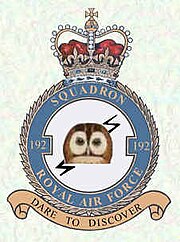| No. 192 Squadron RAF | |
|---|---|
 Official squadron badge of No. 192 Squadron RAF Official squadron badge of No. 192 Squadron RAF | |
| Active | 5 Sep 1917 – Dec 1918 4 Jan 1943 – 22 Aug 1945 15 Jul 1951 – 21 Aug 1958 |
| Country | |
| Branch | |
| Motto(s) | Dare to Discover |
| Insignia | |
| Squadron Badge heraldry | In front of a flash of lightning, an owl's head affrontée |
| Squadron Codes | DT |
No. 192 Squadron was a Royal Air Force squadron operational during the First World War as a night training squadron and during the Second World War as a radar countermeasure unit. After the war the squadron served again in the Electronic Intelligence role, until disbanded in 1958.
History
Formation in World War I
No. 192 Squadron was formed at Gainsborough, Lincolnshire on 5 September 1917 as a night training squadron operating the Royal Aircraft Factory FE.2b and FE.2d. The squadron moved to Newmarket, Suffolk in 1918 and was disbanded in December 1918.
Reformation in World War II
The squadron was re-formed on 4 January 1943 when No. 1474 Flight at RAF Gransden Lodge was re-numbered 192 (Special) Squadron. The squadron operated specially modified Vickers Wellingtons and de Havilland Mosquitos to identify German radar patterns and wavelengths. It also carried out similar missions over the Bay of Biscay and the Mediterranean. In April 1943 the squadron moved to RAF Feltwell and at the end of the year, the squadron moved again to RAF Foulsham to operate with 100 (Bomber Support) Group. During bomber raids the aircraft would provide countermeasures against German radars. The squadron disbanded at the end of the Second World War on 22 August 1945 to form the basis of the Central Signals Establishment and the Radio Warfare Establishment (RWE).
Reformed again in the Cold War
On 15 July 1951, the squadron reformed at RAF Watton as part of that same Central Signals Establishment for Operational Signals Research. Despite the name Research in the role, the squadron continued with its traditional ELectronic Signals INTelligence (ELINT) role. The squadron also used the Boeing Washington and English Electric Canberra in the ELINT role. The squadron disbanded on 21 August 1958 at Watton when it was renumbered to 51 Squadron.
Aircraft operated
| From | To | Aircraft | Variant |
|---|---|---|---|
| Sep 1917 | Dec 1918 | Royal Aircraft Factory F.E.2 | F.E.2b and 2d |
| Jan 1943 | Feb 1943 | Vickers Wellington | Mks.Ic, III |
| Jan 1943 | Mar 1945 | Vickers Wellington | Mk.X |
| Jan 1943 | Mar 1945 | de Havilland Mosquito | Mk.IV |
| Mar 1943 | Jul 1943 | Handley Page Halifax | Mk.II |
| Jul 1943 | Mar 1944 | Handley Page Halifax | Mk.V |
| Mar 1944 | Aug 1945 | Handley Page Halifax | Mk.III |
| Feb 1945 | Aug 1945 | de Havilland Mosquito | Mk.XVI |
| Aug 1945 | Aug 1945 | Airspeed Oxford | |
| Aug 1945 | Aug 1945 | Avro Anson | Mk.I |
| Jul 1951 | Sep 1952 | de Havilland Mosquito | PR.34 |
| Jul 1951 | Mar 1953 | Avro Lincoln | B.2 |
| Apr 1952 | Feb 1958 | Boeing Washington | B.1 |
| Jan 1953 | Aug 1958 | English Electric Canberra | B.2 |
| Apr 1954 | Apr 1956 | Vickers Varsity | T.1 |
| Jul 1954 | Aug 1958 | English Electric Canberra | B.6 (Mod) |
| Jul 1957 | Aug 1958 | de Havilland Comet | C.2R or R.2 |
See also
References
Notes
- ^ Rawlings 1982, pp. 125–126.
- ^ Halley 1988, pp.251–252.
- Bowyer and Rawlings 1979, p. 31.
- Flintham and Thomas 2003, p. 69.
- "RAF - Bomber Command No.192 (Special) Squadron". Archived from the original on 4 March 2016.
- ^ Jefford 2001, p. 69.
Bibliography
- Bowyer, Michael J.F. and John D.R. Rawlings. Squadron Codes, 1937–56. Cambridge, UK: Patrick Stephens Ltd., 1979. ISBN 0-85059-364-6.
- Flintham, Vic and Andrew Thomas. Combat Codes: A full explanation and listing of British, Commonwealth and Allied air force unit codes since 1938. Shrewsbury, Shropshire, UK: Airlife Publishing Ltd., 2003. ISBN 1-84037-281-8.
- Halley, James J. The Squadrons of the Royal Air Force & Commonwealth 1918–1988. Tonbridge, Kent, UK: Air Britain (Historians) Ltd., 1988. ISBN 0-85130-164-9.
- Jefford, C.G. RAF Squadrons, a Comprehensive record of the Movement and Equipment of all RAF Squadrons and their Antecedents since 1912. Shrewsbury, Shropshire, UK: Airlife Publishing, 1988 (second edition 2001). ISBN 1-85310-053-6.
- Rees, William J. and John E. Espionage in the Ether: The Wartime Story of Electronic Intelligence & Radio Countermeasures Carried out by 192 (Bomber Support) Squadron. Compaid Graphics, 1999. ISBN 1-900604-11-6.
External links
- Squadron history on MOD site
- History on Air of Authority – A History of RAF Organisation
- 192 Squadron photos, life stories, documents, and memorabilia at the International Bomber Command Centre Digital Archive.
| Royal Air Force | |||||||
|---|---|---|---|---|---|---|---|
| Ministry of Defence | |||||||
| formations and units |
| ||||||
| branches and components | |||||||
| reserve forces | |||||||
| equipment | |||||||
| personnel | |||||||
| appointments | |||||||
| symbols and uniform | |||||||
| associated civil organisations | |||||||
- Royal Air Force aircraft squadrons
- Royal Flying Corps squadrons
- Aircraft squadrons of the Royal Air Force in World War II
- Electronic warfare units and formations
- Signals intelligence units and formations
- Military units and formations established in 1917
- 1917 establishments in the United Kingdom
- Military units and formations disestablished in 1958
- Telecommunications in World War II